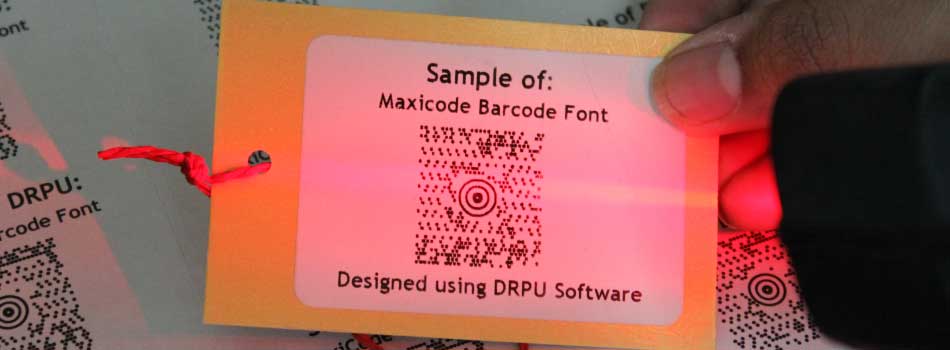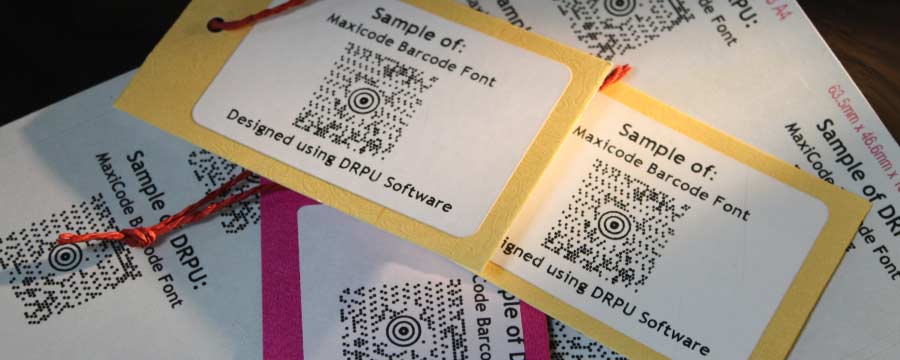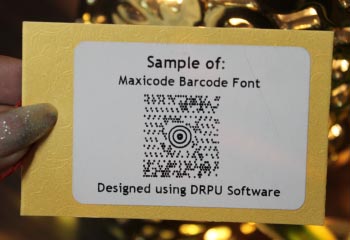Decoding a MaxiCode Barcode
🔖 Tags:About MaxiCode Barcode

MaxiCode is a two-dimensional matrix barcode that was developed by United Parcel Service (UPS) in 1992. It is used to encode a variety of information, including tracking numbers, addresses, and other data related to the shipping and logistics industry. The MaxiCode is made up of hexagonal modules that can be black or white. These modules are arranged in a specific pattern that enables the barcode to be read by a scanner or imaging device. In this article, we will discuss how to decode a MaxiCode barcode.
Decoding a MaxiCode barcode involves using a barcode scanner or an imaging device to capture an image of the barcode, and then using software to interpret the data encoded in the barcode. There are a variety of barcode scanners and imaging devices available on the market, each with its own features and capabilities. Some of these devices are designed specifically for decoding MaxiCode barcodes, while others are capable of decoding multiple types of barcodes.
Introduction
One popular program for decoding MaxiCode barcodes is the ZXing library, which is an open-source software library that can be used for decoding a variety of barcode formats, including MaxiCode. The library is available for free download and can be used with a variety of programming languages, including Java, Python, and C++. To use the ZXing library for decoding a MaxiCode barcode, the first step is to install the library and any necessary dependencies. Once the library is installed, the next step is to write a program that will use the library to decode the barcode image.
To decode a MaxiCode barcode, the first step is to capture an image of the barcode using a scanner or an imaging device. The device should be positioned directly over the barcode so that it can capture a clear image. The device may need to be adjusted to ensure that it is properly focused on the barcode. Once the image has been captured, it can be saved to a computer or other device for processing.
The next step is to use software to interpret the data encoded in the barcode. There are a variety of software programs available for decoding MaxiCode barcodes, including commercial and open-source options. Some of these programs are designed to work with specific types of hardware or operating systems, so it is important to choose a program that is compatible with your device and setup.
However, the basic process involves creating an instance of the library's decoder class, passing in the image of the barcode, and then calling the decode() method to extract the data encoded in the barcode
In summary, decoding a MaxiCode barcode involves using a barcode scanner or an imaging device to capture an image of the barcode, and then using software to interpret the data encoded in the barcode. There are a variety of software programs available for decoding MaxiCode barcodes, including open-source and commercial options. The specific process for decoding a MaxiCode barcode will depend on the hardware and software being used, as well as the programming language used to write the decoding program.
Reading of MaxiCode Barcode by any Barcode Scanner
Not all barcode scanners can read MaxiCode barcodes. MaxiCode is a proprietary barcode symbology that was developed by United Parcel Service (UPS) in the 1990s for use in their logistics and shipping operations. As a result, MaxiCode barcodes are primarily used in the logistics and transportation industries, and are most commonly seen on UPS packages and labels.
-
There are several types of barcode scanners that can read MaxiCode barcodes, including handheld scanners, fixed mount scanners, and mobile computers. Handheld scanners are the most common type of scanner used in logistics and transportation applications, as they are portable and easy to use. Fixed mount scanners are typically used in automated sorting and tracking systems, where packages are scanned as they pass through a conveyor system. Mobile computers are handheld devices that combine barcode scanning with other functions such as inventory management or data entry.
-
Barcode scanners that can read MaxiCode barcodes are typically designed for use in logistics and transportation applications, and may have specialized features such as long-range scanning or ruggedized construction to withstand the harsh conditions of shipping and handling environments.
-
To ensure that a barcode scanner can read MaxiCode barcodes, it is important to check that the scanner supports the MaxiCode symbology and has been configured to read MaxiCode barcodes. Some barcode scanners may require firmware updates or configuration changes to enable MaxiCode scanning.
However :- MaxiCode barcodes can be read by any barcode scanner that supports the MaxiCode symbology. MaxiCode is a two-dimensional (2D) matrix barcode that encodes information using a hexagonal pattern of dots. The data is encoded using a Reed-Solomon error correction algorithm, which allows the barcode to be scanned accurately even if some of the dots are missing or damaged.
Overall :- While MaxiCode is a proprietary barcode symbology that is primarily used in the logistics and transportation industries, it can be read by any barcode scanner that supports the MaxiCode symbology. Barcode scanners that can read MaxiCode barcodes are widely available and can be used in a variety of applications, from shipping and logistics to inventory management and asset tracking.
The Advantages of Using a MaxiCode Barcode
MaxiCode is a 2D barcode that has several advantages over other types of barcodes, including:
-
Error Correction:
MaxiCode includes a built-in error correction mechanism that can correct up to 25% of damaged or missing data. This means that even if part of the barcode is damaged, it can still be read accurately.
-
Easy to Read:
MaxiCode is easy to read and scan, even from a distance. This makes it ideal for applications where fast scanning and processing are essential, such as in logistics and supply chain management.
-
High Information Capacity:
MaxiCode can store up to 93 alphanumeric characters, making it suitable for storing large amounts of data. This makes it ideal for applications where a large amount of data needs to be stored in a small space.
-
High Security:
MaxiCode has a high level of security, which makes it suitable for applications where security is a concern. It can be encrypted to prevent unauthorized access, and its large information capacity means that it can store complex information.
-
Global Standard:
MaxiCode is a global standard barcode, which means that it is widely recognized and used around the world. This makes it ideal for those applications that require international compatibility.
-
Flexibility:
MaxiCode can be printed on a variety of surfaces, including paper, plastic, and metal. This means that it can be used in a wide range of applications, from product labeling to asset tracking.
-
Integration with Existing Systems:
MaxiCode can be integrated with existing systems, such as warehouse management systems and transportation management systems. This means that it can be used to improve efficiency and accuracy in a range of applications.
Download and Install
Barcode Label Maker SoftwareThe Limitations of Using a MaxiCode Barcode
MaxiCode is a two-dimensional matrix barcode that can store large amounts of information in a compact format. While MaxiCode has several advantages, it also has some limitations. In this response, we will discuss the limitations of MaxiCode Barcodes.

-
Limited Data Capacity:
One of the limitations of MaxiCode is its limited data capacity. MaxiCode can store up to 93 alphanumeric characters or 138 numeric characters, which is significantly less than some other 2D barcodes such as DataMatrix or QR Code. This makes MaxiCode less suitable for applications where large amounts of data need to be encoded, such as in supply chain management or asset tracking.
-
Limited Scan Distance:
Another limitation of MaxiCode is its limited scan distance. MaxiCode requires a scanner to be in close proximity to the code to be read correctly. The optimal scanning distance for a MaxiCode is typically less than 6 inches. This makes MaxiCode less suitable for applications where scanning at a distance is required, such as in warehouse or shipping environments.
-
Limited Error Correction:
MaxiCode uses Reed-Solomon error correction to ensure that the code can be read even if parts of it are damaged or obscured. However, the level of error correction in MaxiCode is limited compared to other 2D barcodes such as QR Code or DataMatrix. This means that if a MaxiCode is damaged or obscured, it may not be able to be read correctly, leading to data loss or errors.
-
Limited Application:
MaxiCode is primarily used in the logistics and transportation industries for package tracking and routing. While it is a highly effective solution for these applications, it may not be suitable for other applications that require different types of data or encoding structures. This means that MaxiCode may not be a viable solution for a wide range of industries or use cases.
-
Limited Standardization:
MaxiCode is not as widely used or standardized as other 2D barcodes such as QR Code or DataMatrix. This can make it more difficult to integrate MaxiCode into existing systems or to ensure compatibility with different types of scanners or software. In some cases, it may be necessary to use custom software or hardware to decode MaxiCode, which can be costly and time-consuming.
In conclusion, MaxiCode has some limitations that make it less suitable for certain applications. However, it is still a highly effective solution for logistics and transportation industries, and its compact size and ease of integration make it a popular choice for these applications. As with any technology, it is important to consider the specific requirements of your application and choose a solution that best meets your needs.
